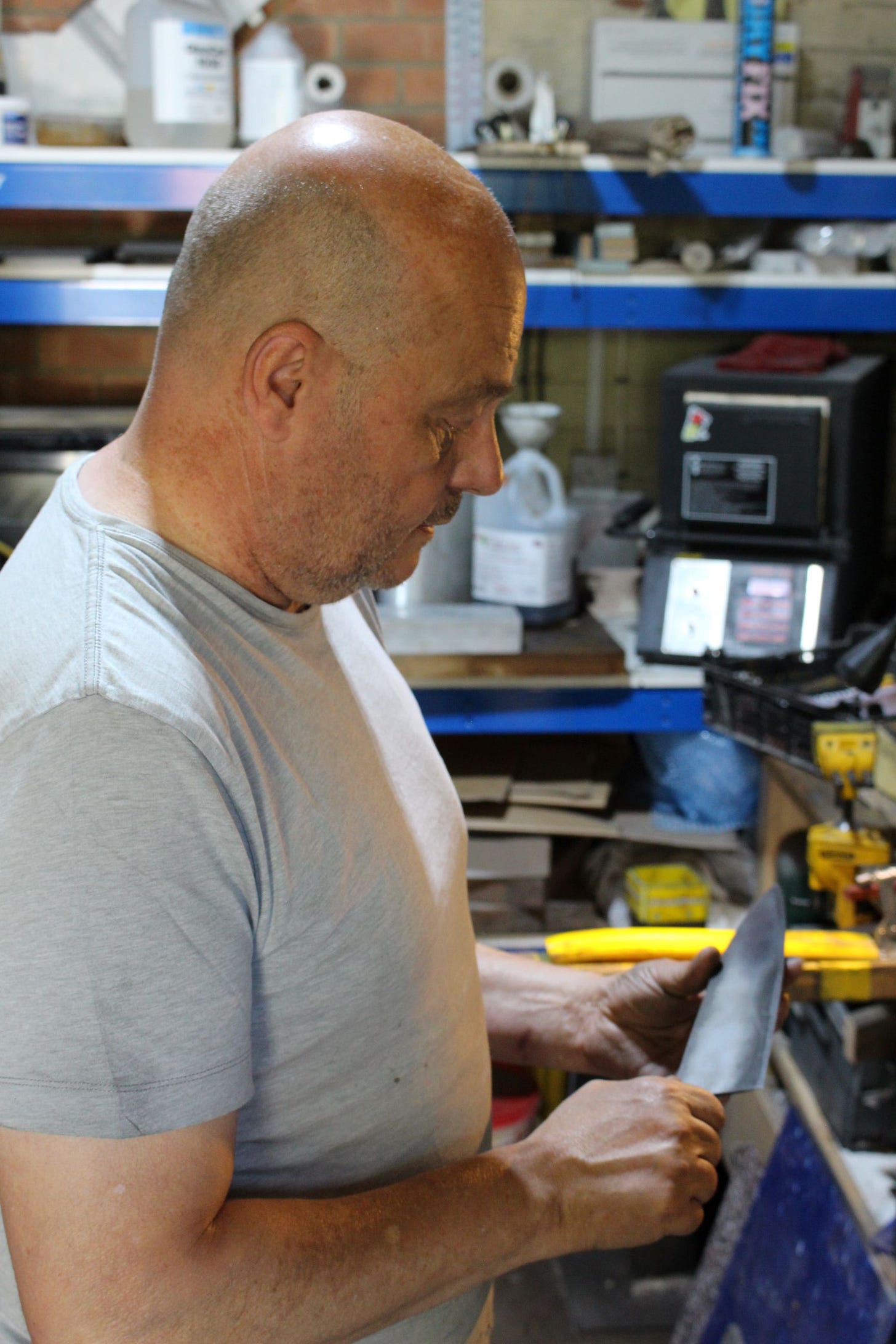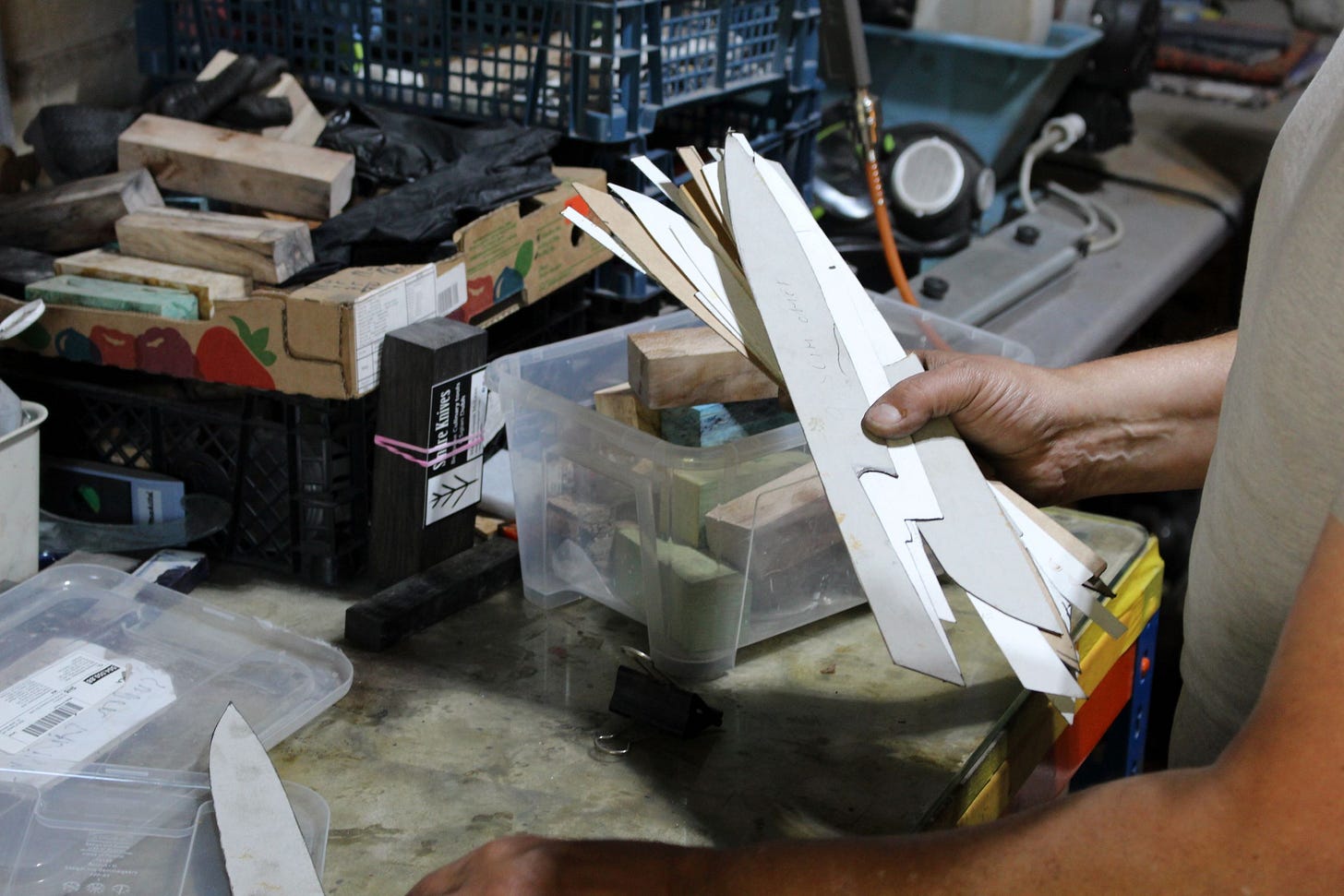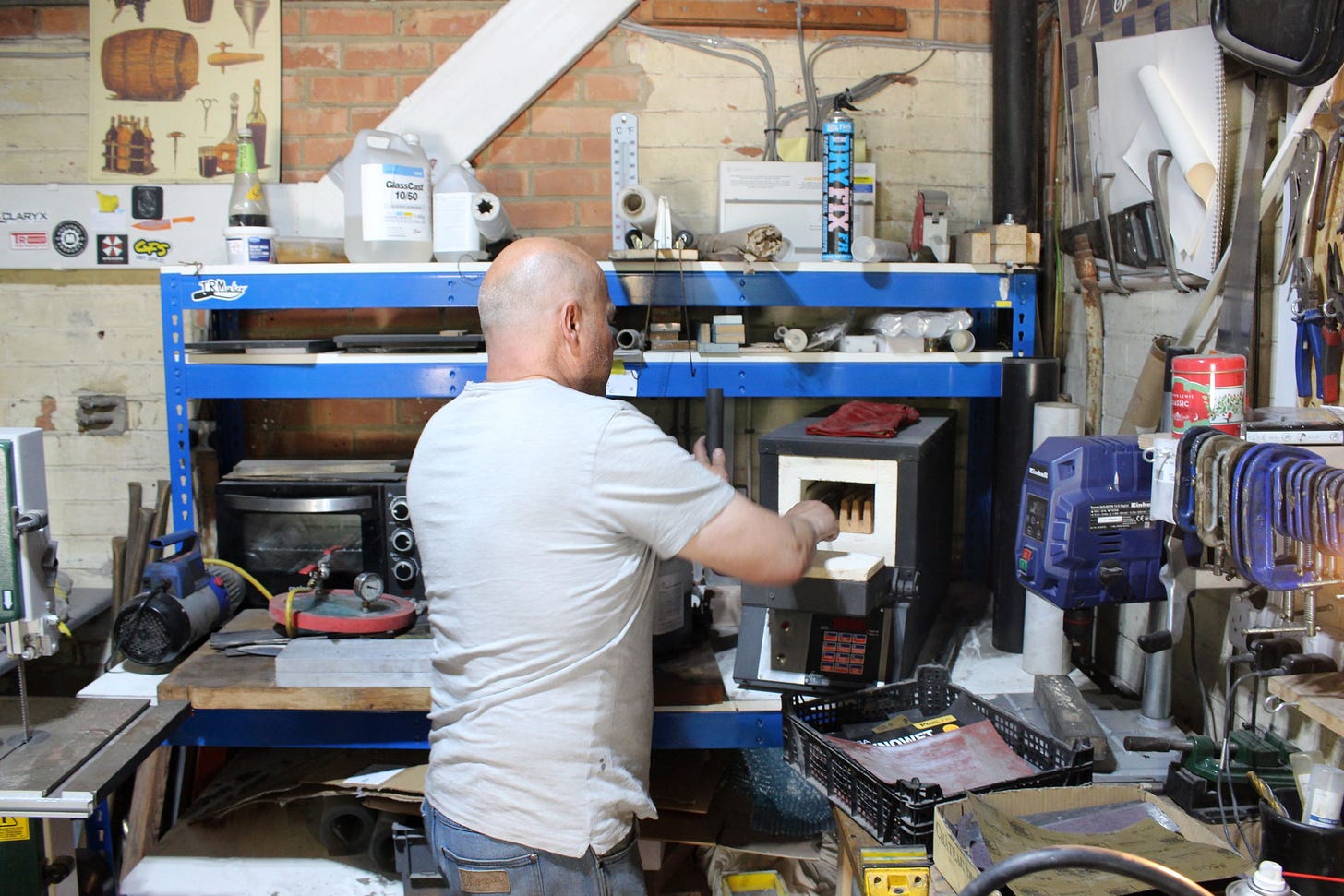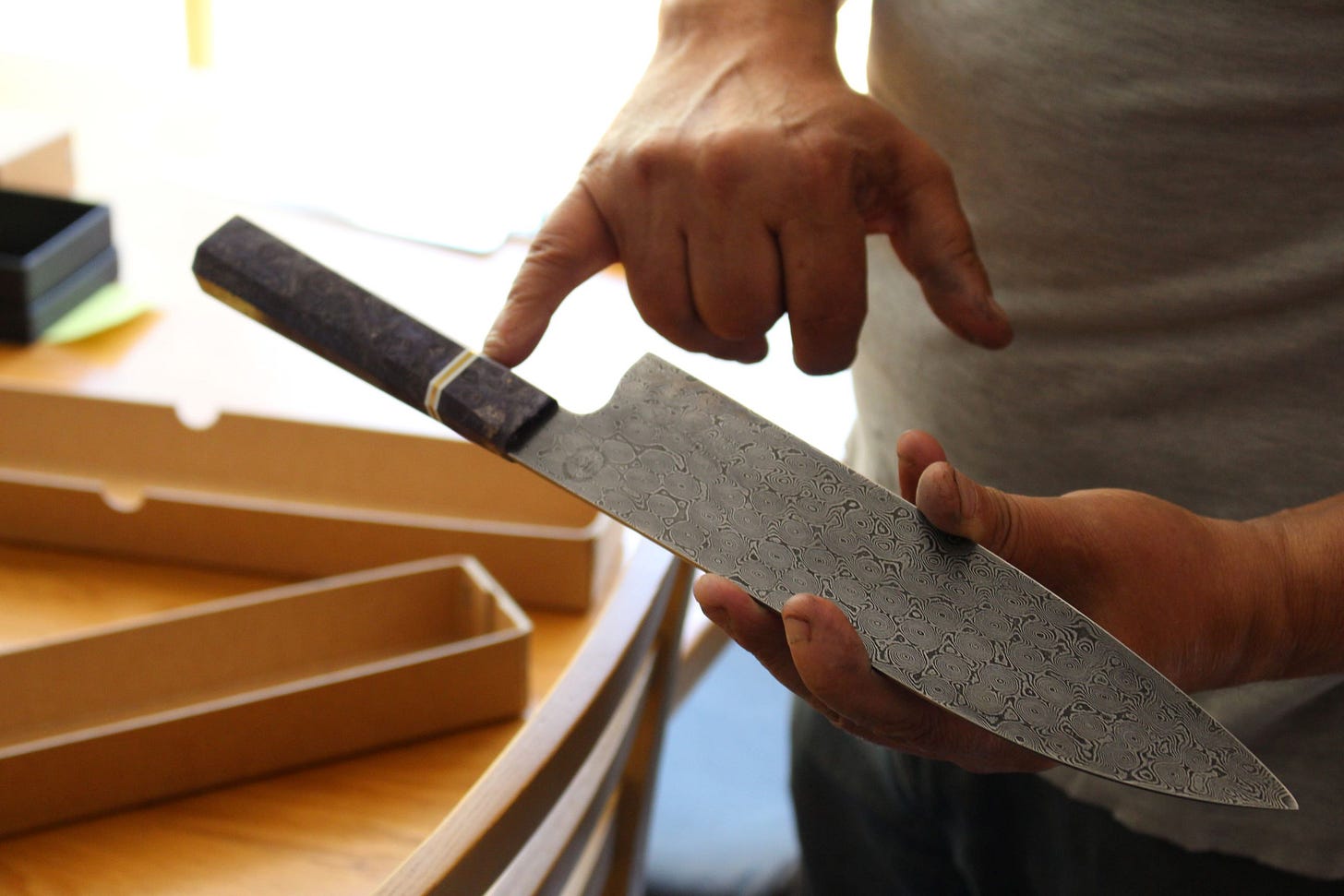I've never been one to overthink my kitchen knives. Good knives have always been one expense more than my pay check. A multifaceted artform with a practical use, knifemaking is, for some, the epitome of where beauty and utility collide. To me, knifemakers are characters that reside in the pages of Man Booker Prize winning novels, moody and distant.
Bernard Caille, despite his sometimes brusque French persona, is undoubtedly modest and hospitable, selling knives to top chefs whilst collaborating with other craftspeople to source and experiment with new materials. He invites me to see where and how he hones his craft. The basement of Notre Dame? In a steampunk cutlery draw? No.
The workshop he has created in the garden of his suburban home in Nottingham.
The doors are swung back to let in the late summer sun. Each door is adorned with the wreaths of knifemakers — circular ribbons of sanding paper. A wide worktop runs down either side of the breezeblock building, scattered with tools for filing, buffing, and clamping. Above these worktops are two shelves lined with clear plastic boxes of materials.
Bernard is waiting for us in a t-shirt, jeans, a broad smile, and the tan from the Portuguese break he's just returned from. As we chat, he pulls down boxes in turn, using their contents to exemplify the process he is explaining to us in his French accent. In so doing he proves himself as a maker — both his learning and his teaching is in the showing. This is knifemaking in practice, not just in theory. He starts by sharing with us his latest creation in progress.
"So I have this blade which I made a few months ago. It's stainless steel." As he speaks, he spins a clamp, releasing the tension so he can remove the blade and pass it to me. Holding it with two fingers pinched around its blunt edge, this proto-knife without its handle feels odd to hold.The curve of the blade leads to a tapered end where its handle will be slotted on.
"Before I left for holiday a couple of weeks ago, I took some of this bog oak and stabilised it." Bernard picks up the handle from the worksurface behind us, turns it in his palm, and runs his fingers across its surface before he has an idea. He hands me the bog oak as he reaches for a tupperware on the top shelf. Inside are handles of different woods and shapes. Each he weighs in his hand and considers before laying them on the work surface for us to look at.
"This came from one of the other knife makers I know, in Scotland, but I think he got it from Ukraine. Some of the northern European countries have this as well, and France. This one," he motions to the original handle, "I was told this came from Lincolnshire."
He picks up another.
"We have to stabilise the wood, to make it better to work with. Like this one, this bit of vine that was given to me from Burgundy. Maybe the vine has fungi or something. So I put the wood into a pressurised machine with a resin called cactus juice. This penetrates the wood, and stabilises it so it's better to work with. Here, “he pulls down another box and hunts out a different handle, “feel this.”
This handle is heavier, denser where the resin has seeped into the old wood. As he talks, he finds other handles — some stabilised, others not yet — spalted beech, walnut, cade wood from southern France that smells like juniper and sandalwood.
Not everybody is looking for a wooden-handled knife though, which feeds Bernard's need to create and collaborate.
The array of wooden handles returned to their shelf he shows us what else he is working with. First, handles made from recycled plastic created by a company called Smile Plastics, based in Wales, "it polishes really well, shines really well," he says. Next is Richlite handles, recycled paper stabilised with organic resin, which Bernard sources from America. His review? "Very stable. Richlite is easy to work with, very easy to polish, very easy to grind."
He pulls down cardboard templates for the different shapes of knife that he can create. How useless these paper cutout knives would be in the kitchen helps to emphasise how many stages there are between Bernard’s imagination and his end creations. "This is my most popular,” he separates a smaller template from the pile, “I call it the everyday knife, it's the European style."
European? "A piece of steel, with bits of wood for the handle on each side," he takes a blunt blade and sandwiches it between two handles in the palms of his hands, then picks up a template with a tapered end, like the blade I first held. "The others that I do are Japanese knives , like these. I always thought they were talking about the metal, but it's Japanese shape, where you slot the handle on to the blade. It's more for a push cut than a rocking cut."
"Once I have grinded the blade into shape using the different grits of sandpaper, then I'll hone the blade. It's all about the geometry”
At this word equations fill my mind. How to translate maths to the chopping board is not something I can comprehend. It turns out, though, the overall idea is easy to grasp, “When I started, I was making a lot of a flat grind. When you cut your food, it will stick to the side of the knife. This one, it's convex, it's got that bevelling,” he runs his hand through the air like stoking down the back of a cat, “The food falls off more easily."
He takes a step to the back of the workshop, where equipment that look like intense slow cookers roost, waiting for their time to shine. Bernard opens the door to one that looks like a small kiln.
"When the shaping is done, I heat treat the steel. Every steel, nice steel, has a recipe to it. You take it to a certain temperature, like it's cooking. Let's say something like this stainless steel, I take to 1060 degrees Celsius. Then it is quenched, cooled quickly, and then relaxed again at a lower temperature. That, with the shaping, gives you any flexibility you might like."
There’s a lot to take in. An understanding of multiple materials, how heat effects them, the durability of all of the parts of a knife and, ultimately, how beauty and utility are captured in one, final knife.
How, then, does a father of two become a knife maker fluent in the world of cactus juice, Richlite, and quenching?
Bernard leans back against the worksurface to explain, one hand gesturing to mark the passing of time.
"In the eighties in France, where I'm from, either you did a normal baccalaureate, or, if you were very naughty, as I was, they sent you to the technical college. At the age of thirteen — thirteen and a half— I was sent to learn metalworking. I spent the next three years welding, blacksmithing,” he gently smiles as he tells his story, perhaps slightly proud of where the full circle of his teenage misadventures have landed him.
"Then, later, I was in wine for a long time, working in shops and for myself. This garage was filled with boxes of wine, from here," he laughs, motioning to the front of his workshop, "all the way to the back!"
"In 2003 I stopped that, moving into various industries. Then I started learning about knifemaking. Now I'm using better steels, more complex steels, and more sustainable products to create knives that are aesthetically pleasing and that I, and my clients, want to use in the kitchen, that keep the sharpest edge."
We talk for two hours. Each tangent of the conversation brings with it a new material pulled from the shelves, another piece of information about a future project, or a fresh story about a process of experimentation.
I think about my knives. My most used is probably a chef's knife I stole from my fourth-year flat at the end of university, or maybe another that came free with a set of pans. Efficiency is what they bring me. They’re inoffensive.
Bernard introduces me to his knifemaking world. In his kitchen he unboxes knife after knife — the mottled blades of Damascus steel and the wavey blue handles of compressed denim. With each he brings an understanding, and a gentle frazzle of distinct enjoyment and care.
It seems fitting that, one hour down the road from Sheffield, the heart of the UK’s steel industry, Bernard has found a space where his creativity meets between beauty and utility. And in that moment, I think that it’s time to find a new knife.
Bernard’s knives can be purchased and commissioned from nottinghamknifeworks.co.uk/









